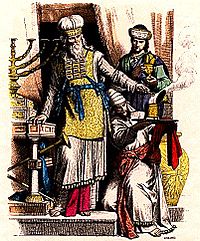Biblical clothing
The clothing of the people in biblical times was made from wool, linen, animal skins, and perhaps silk.
Complete descriptions of the styles of dress among the people of the Bible is impossible because the material at hand is insufficient.
[1] Assyrian and Egyptian artists portrayed what is believed to be the clothing of the time, but there are few depictions of Israelite garb.
[2] The earliest and most basic garment was the ʿezor (/eɪˈzɔːr/ ay-ZOR, all pronunciations are approximate)[4] or ḥagor (/hɑːˈɡɔːr/ khə-GOR),[5] an apron around the hips or loins,[3] that in primitive times was made from the skins of animals.
[1] The ʿezor later became displaced among the Hebrews by the ketonet or tunic (/kəˈθoʊnɛθ/ kə-THAW-net,[7] translated into Greek as chitōn[8]) an undertunic,[1][3] corresponding most nearly to a long shirt.
[3] It consisted of a large rectangular piece of rough, heavy woolen material, crudely sewed together so that the front was unstitched and with two openings left for the arms.
"[8] During the day, it was protection from rain and cold, and at night when traveling Israelites could wrap themselves in this garment for warmth on their journey during the Three Pilgrimage Festivals of Deuteronomy 16:16.
From this simple item of the common people developed the richly ornamented mantle of the well-off, which reached from the neck to the knees and had short sleeves.
The me'ı̄l was a costly wrap (1Samuel 2:19, 1Samuel 18:4, 1Samuel 24:5, 1Samuel 24:11) and the description of the priest's meʿil was similar to the sleeveless bisht[3] (Exodus 28:31; Antiquities of the Jews, III.
This, like the meʿil of the high priest, may have reached only to the knees, but it is commonly supposed to have been a long-sleeved garment made of a light fabric.
[3] The Torah commanded that Israelites wear tzitzit, tassels or fringes (ṣiṣit, /tsiːˈtsiːt/ tsee-TSEET[17]) attached to the corners of garments (see Deuteronomy 22:12, Numbers 15:38–39).
Phylacteries or tefillin are boxes containing biblical verses attached to the forehead and arm by leather straps,[18] and were in use by the late Second Temple period (see Matthew 23:5).
[3] Hebrew people undoubtedly also wore head coverings similar to the modern keffiyeh, a large square piece of woolen cloth folded diagonally in half into a triangle.
[3] The fold is worn across the forehead, with the keffiyeh loosely draped around the back and shoulders, often held in place by a cord circlet.
Men and women of the upper classes wore a kind of turban, cloth wound about the head.
A large number of Jews (such as Jeremiah) also began permanent residence in Egypt upon the destruction of Jerusalem in 587 BC, during the Third Intermediate Period.
Women often wore simple sheath dresses, and female clothing remained unchanged over several millennia, save for small details.
Both men and women adorned themselves with earrings, bracelets, rings, necklaces and neck collars that were brightly colored.
Despite popular imagination and media depictions of all-white clothing, elaborate design and bright colors were favored.
The basic outer garment during winter was the himation, a larger cloak worn over the peplos or chiton.
The Roman general Pompey entered Jerusalem in 63 BC, ending Judean national independence.
Probably the most significant item in the ancient Roman wardrobe was the toga, a one-piece woolen garment that draped loosely around the shoulders and down the body.
Because it was not easy to wear a toga without tripping over it or trailing drapery, some variations in wrapping served a practical function.
Women wore an outer garment known as a stola, which was a long pleated dress similar to the Greek chitons.
In ancient Rome women athletes wore leather briefs and brassiere for maximum coverage but the ability to compete.
This entry incorporates text from the public domain International Standard Bible Encyclopedia, originally published in 1915.








